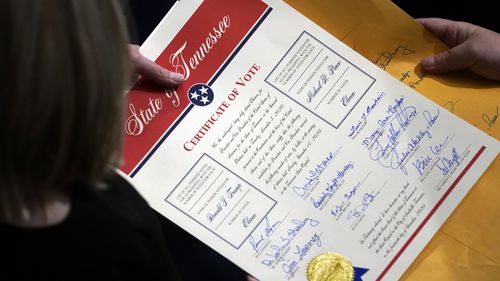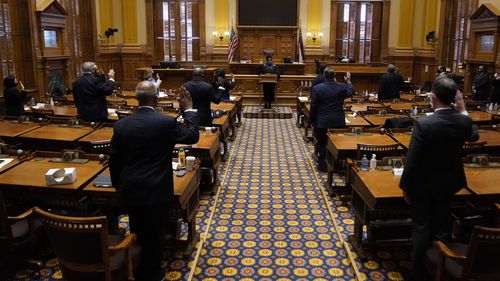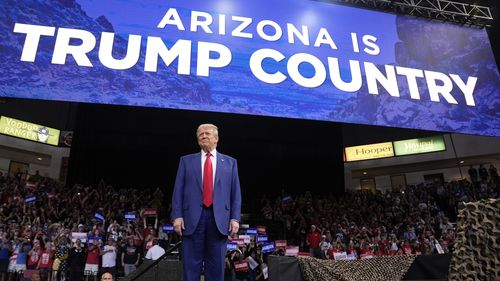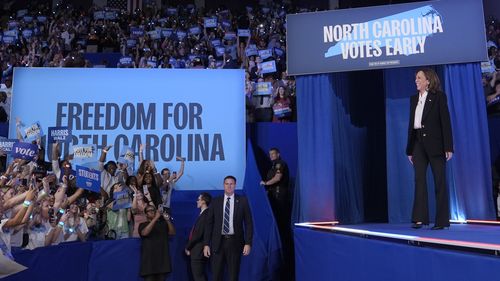When the United States heads to the polls for the election, the popular vote won’t decide whether Kamala Harris or Donald Trump becomes president.
Instead, it will be whoever wins the most Electoral College votes.
It’s a political system that’s vastly different from our own here in Australia – and it’s not without its critics. Here’s how it works.

How does the Electoral College system work?
Each state plus the District of Columbia is allocated a number of Electoral College votes.
Whichever presidential candidate wins the popular vote in each state gets all of that state’s electoral votes.
There are two exceptions: in both Maine and Nebraska, two votes go to whoever takes the popular vote, while the remaining two and three respectively are given to the candidate who is more popular in each of the states’ Congressional districts.
There are a total of 538 Electoral College votes, so whichever candidate wins at least 270 wins the presidency.
Do states all get the same number of votes?
No.
Every state has the same number of Electoral College votes as it does representatives in the Senate and Congress combined.
While each state has two Senate seats, the number of Congressional districts varies depending on population.
The fewest Electoral College votes for a state is three – six have that many, as well as the District of Columbia, even though as a district it doesn’t have any senators or congressmen.
California has the most at 54.

How are Electoral College votes counted?
While voters across the country fill out a ballot with the presidential candidates’ names, in effect they’re actually voting for which “slate” of electors they will send when the Electoral College convenes following the election.
These are chosen by each party before the election and are generally officials and party loyalists, although it varies from state to state.
In the states that Kamala Harris wins this year, the Democratic slate of electors will be sent to the Electoral College convention on December 17, while Trump-voting state will send their Republican slate.
The electors cast their votes when the Electoral College meets, with the results then sent to Congress to be certified.

What are the issues with the Electoral College?
Having been created by the Founding Fathers, who debated whether to have the presidency decided by the people or Congress, the Electoral College is now nearly a quarter of a millennium old.
As you’d expect from a system that was thought up the best part of 250 years ago, there are a number of criticisms of it.
One of the most obvious is that the Electoral College doesn’t represent the popular vote.
While historically rare, two of the last six elections were won by the candidate with fewer votes across the nation – Trump in 2016 and George Bush in 2000. It also happened three times in the 1800s.
Polling this year is tight enough to suggest a similar result could once again be on the cards.

Part of this is down to representation: the Electoral College gives far more weight to sparsely populated states compared to bigger ones.
Take California and Texas, as a couple of examples. As two heavily populated states, they have the two most electors with 54 and 40 respectively – one Electoral College vote per roughly 722,000 and 750,000 people respectively.
Wyoming, on the other hand, has three electoral votes for its population of about 580,000 – giving it a far more influential one elector per 200,000 residents.
The Electoral College also doesn’t do a very good job of representing all voters in a state, due to all electoral votes going to the more popular candidate, regardless of whether they win by 10 per cent or 0.01 per cent.
Again, let’s take California as an example. In 2020, Joe Biden won the state by more than five million votes, netting him 55 electoral votes.
If an extra four million people there had voted for Donald Trump, Joe Biden still would have got 55 electoral votes.
This leads us to the inflated influence of battleground areas.
In most states, the winners are close to foregone conclusions. Harris will win California, the District of Columbia and Vermont. Trump will take Wyoming, West Virginia and Oklahoma.
There are dozens more like that – only seven states are thought to be genuinely in play for both Trump and Harris.
As we’ve established, an extra four million votes for Trump in California in 2020 would have had absolutely no impact on the election outcome.
But had he snatched an extra 45,000 across Georgia, Arizona and Wisconsin, he would have flipped those states and won the election.

The result? Campaigns focus heavily on the battlegrounds and largely ignore the rest of the country.
“It’s not so much the candidates as it is the anti-democratic Electoral College,” Matt Muchowski said.
He’s the chair of the Democratic club in Waukegan, Illinois, a majority Latino working-class city that has struggled as its factories closed and waterfront deteriorated.
Because it’s a Democrat stronghold, Illinois is mostly bypassed by presidential candidates even as its neighbour to the north, Wisconsin, is a common stomping ground for presidential hopefuls.
“It’s frustrating that certain voters’ votes count for more, and they discount and discredit the votes of more urban, more people of colour voters,” Muchowski said.

Will the Electoral College be changed or removed?
Because the Electoral College is enshrined in the Constitution, removing or changing it is extremely difficult and requires a level of consensus that is rare in US politics these days – it’s been more than 30 years since the last successful amendment.
To get around that, some states have signed up to a system that would see them pledge their electoral votes to whoever wins the national popular vote, regardless of the outcome in their state.
Known as the National Popular Vote Interstate Compact, it would need states with a combined 270 electoral votes to commit to it to come into effect.
Having been introduced in 2004, it’s currently at 17 states and the District of Columbia, worth 209 votes, although would likely face legal challenges even if it does meet the threshold.
